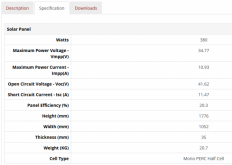Matty-Lee
New Member
- Joined
- Jan 21, 2021
- Messages
- 49
Hello all,
First post and I know fairly little about the subject of DIY solar but I'm building a camper van and want to build my own 12v LiFePO4 battery for use with solar, all with the help of YouTube.
I've bought the 4 3.2v cells and I'm waiting for them to arrive.
Today the 60A Daly BMS I ordered has arrived and I'm just confused by the Discharge current being 60A and the Charge current being 30A.

I plan to run a 12v system powered by a single 380W solar panel which will feed into a 40A charge controller which will then charge the 12v battery through this BMS.
By my calculations I'd only require a 30A charge controller but I went a little higher for upgrade-ability.
For the same reason I thought I'd go a little higher on the BMS and choose the 60A option but looking at it, is says 30A for charging.
Could someone clear up the difference between the Discharge current and the Charge current and tell me if this BMS is OK to use with the system?
Thank you,
Matt
First post and I know fairly little about the subject of DIY solar but I'm building a camper van and want to build my own 12v LiFePO4 battery for use with solar, all with the help of YouTube.
I've bought the 4 3.2v cells and I'm waiting for them to arrive.
Today the 60A Daly BMS I ordered has arrived and I'm just confused by the Discharge current being 60A and the Charge current being 30A.

I plan to run a 12v system powered by a single 380W solar panel which will feed into a 40A charge controller which will then charge the 12v battery through this BMS.
By my calculations I'd only require a 30A charge controller but I went a little higher for upgrade-ability.
For the same reason I thought I'd go a little higher on the BMS and choose the 60A option but looking at it, is says 30A for charging.
Could someone clear up the difference between the Discharge current and the Charge current and tell me if this BMS is OK to use with the system?
Thank you,
Matt




